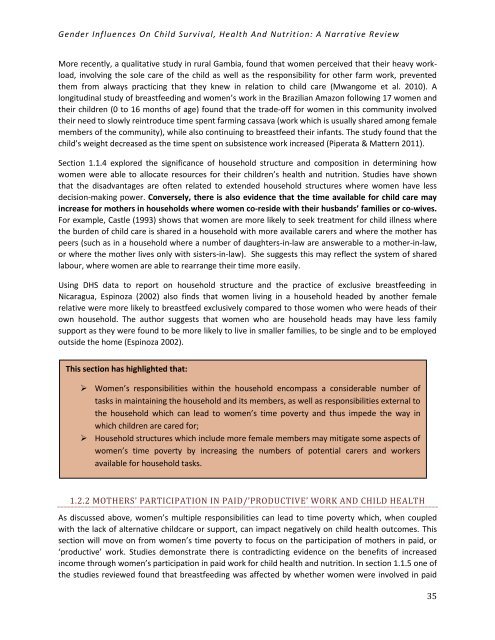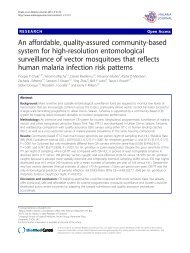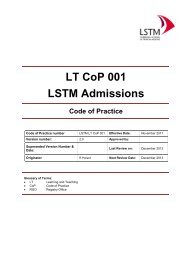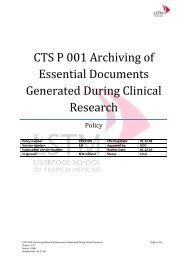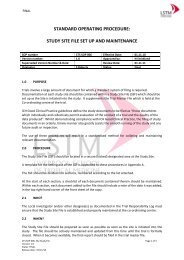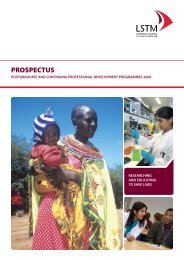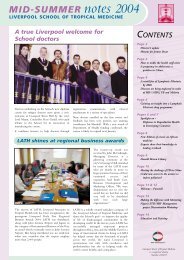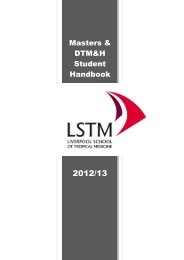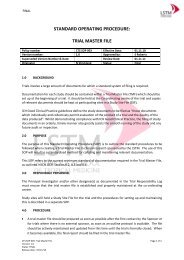Gender influences on child survival, health and nutrition: a ... - Unicef
Gender influences on child survival, health and nutrition: a ... - Unicef
Gender influences on child survival, health and nutrition: a ... - Unicef
You also want an ePaper? Increase the reach of your titles
YUMPU automatically turns print PDFs into web optimized ePapers that Google loves.
<str<strong>on</strong>g>Gender</str<strong>on</strong>g> Influences On Child Survival, Health And Nutriti<strong>on</strong>: A Narrative Review<br />
More recently, a qualitative study in rural Gambia, found that women perceived that their heavy workload,<br />
involving the sole care of the <strong>child</strong> as well as the resp<strong>on</strong>sibility for other farm work, prevented<br />
them from always practicing that they knew in relati<strong>on</strong> to <strong>child</strong> care (Mwangome et al. 2010). A<br />
l<strong>on</strong>gitudinal study of breastfeeding <strong>and</strong> women’s work in the Brazilian Amaz<strong>on</strong> following 17 women <strong>and</strong><br />
their <strong>child</strong>ren (0 to 16 m<strong>on</strong>ths of age) found that the trade-off for women in this community involved<br />
their need to slowly reintroduce time spent farming cassava (work which is usually shared am<strong>on</strong>g female<br />
members of the community), while also c<strong>on</strong>tinuing to breastfeed their infants. The study found that the<br />
<strong>child</strong>’s weight decreased as the time spent <strong>on</strong> subsistence work increased (Piperata & Mattern 2011).<br />
Secti<strong>on</strong> 1.1.4 explored the significance of household structure <strong>and</strong> compositi<strong>on</strong> in determining how<br />
women were able to allocate resources for their <strong>child</strong>ren’s <strong>health</strong> <strong>and</strong> nutriti<strong>on</strong>. Studies have shown<br />
that the disadvantages are often related to extended household structures where women have less<br />
decisi<strong>on</strong>-making power. C<strong>on</strong>versely, there is also evidence that the time available for <strong>child</strong> care may<br />
increase for mothers in households where women co-reside with their husb<strong>and</strong>s’ families or co-wives.<br />
For example, Castle (1993) shows that women are more likely to seek treatment for <strong>child</strong> illness where<br />
the burden of <strong>child</strong> care is shared in a household with more available carers <strong>and</strong> where the mother has<br />
peers (such as in a household where a number of daughters-in-law are answerable to a mother-in-law,<br />
or where the mother lives <strong>on</strong>ly with sisters-in-law). She suggests this may reflect the system of shared<br />
labour, where women are able to rearrange their time more easily.<br />
Using DHS data to report <strong>on</strong> household structure <strong>and</strong> the practice of exclusive breastfeeding in<br />
Nicaragua, Espinoza (2002) also finds that women living in a household headed by another female<br />
relative were more likely to breastfeed exclusively compared to those women who were heads of their<br />
own household. The author suggests that women who are household heads may have less family<br />
support as they were found to be more likely to live in smaller families, to be single <strong>and</strong> to be employed<br />
outside the home (Espinoza 2002).<br />
This secti<strong>on</strong> has highlighted that:<br />
‣ Women’s resp<strong>on</strong>sibilities within the household encompass a c<strong>on</strong>siderable number of<br />
tasks in maintaining the household <strong>and</strong> its members, as well as resp<strong>on</strong>sibilities external to<br />
the household which can lead to women’s time poverty <strong>and</strong> thus impede the way in<br />
which <strong>child</strong>ren are cared for;<br />
‣ Household structures which include more female members may mitigate some aspects of<br />
women’s time poverty by increasing the numbers of potential carers <strong>and</strong> workers<br />
available for household tasks.<br />
1.2.2 MOTHERS’ PARTICIPATION IN PAID/’PRODUCTIVE’ WORK AND CHILD HEALTH<br />
As discussed above, women’s multiple resp<strong>on</strong>sibilities can lead to time poverty which, when coupled<br />
with the lack of alternative <strong>child</strong>care or support, can impact negatively <strong>on</strong> <strong>child</strong> <strong>health</strong> outcomes. This<br />
secti<strong>on</strong> will move <strong>on</strong> from women’s time poverty to focus <strong>on</strong> the participati<strong>on</strong> of mothers in paid, or<br />
‘productive’ work. Studies dem<strong>on</strong>strate there is c<strong>on</strong>tradicting evidence <strong>on</strong> the benefits of increased<br />
income through women’s participati<strong>on</strong> in paid work for <strong>child</strong> <strong>health</strong> <strong>and</strong> nutriti<strong>on</strong>. In secti<strong>on</strong> 1.1.5 <strong>on</strong>e of<br />
the studies reviewed found that breastfeeding was affected by whether women were involved in paid<br />
35


